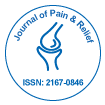Comprehensive Approaches to Pain Therapy
Received: 01-Jan-2025 / Manuscript No. jpar-25-163055 / Editor assigned: 03-Jan-2025 / PreQC No. jpar-25-163055(PQ) / Reviewed: 17-Jan-2025 / QC No. jpar-25-163055 / Revised: 22-Jan-2025 / Manuscript No. jpar-25-163055(R) / Published Date: 29-Jan-2025
Abstract
Pain is a multifaceted experience that can significantly affect an individual's quality of life, manifesting as either acute or chronic pain. Effective pain management is crucial for improving patient outcomes and overall well-being. This article provides an overview of various pain therapy modalities, including pharmacological treatments, physical therapy, interventional procedures, psychological approaches, and complementary therapies. It highlights the importance of a multidisciplinary approach to pain management, emphasizing the need for personalized treatment plans tailored to individual patient profiles. Additionally, the article discusses emerging trends in pain therapy, such as personalized medicine, telehealth, and regenerative medicine, which offer new avenues for alleviating pain. By integrating these diverse strategies, healthcare providers can enhance the effectiveness of pain management and improve the quality of life for those affected by pain.
Keywords
Pain management; Acute pain; Chronic pain; Pharmacological treatments; Physical therapy; Interventional procedures; Complementary therapies; Personalized medicine; Telehealth; Regenerative medicine; Pain relief; Nerve blocks; Mindfulness techniques; Patient outcomes
Introduction
Pain is a complex and subjective experience that can significantly impact an individual's quality of life. It can arise from various causes, including injury, surgery, chronic conditions, and psychological factors. Effective pain management is essential for improving patient outcomes and enhancing overall well-being. This article explores the different modalities of pain therapy, their applications, and emerging trends in the field [1].
Types of pain
Pain can be classified into two main categories:
Acute pain: This type of pain is typically short-term and results from a specific injury or condition. It serves as a warning signal for the body and usually resolves as the underlying issue heals.
Chronic pain: Chronic pain persists for longer than three months and may continue even after the initial injury has healed. It can be associated with conditions such as arthritis, fibromyalgia, and neuropathy [2].
Pain therapy modalities
Pharmacological treatments:
Non-opioid analgesics: Medications such as acetaminophen and nonsteroidal anti-inflammatory drugs (NSAIDs) are commonly used for mild to moderate pain relief.
Opioids: Stronger medications like morphine and oxycodone are prescribed for severe pain but come with risks of addiction and side effects [3].
Adjuvant medications: Antidepressants and anticonvulsants can be effective for certain types of pain, particularly neuropathic pain.
Physical therapy: Physical therapy involves exercises and techniques designed to improve mobility, strength, and function. It can be particularly beneficial for musculoskeletal pain and rehabilitation after injury or surgery [4].
Interventional procedures:
Nerve blocks: Injections that target specific nerves can provide temporary pain relief for various conditions.
Epidural steroid injections: These are used to reduce inflammation and alleviate pain in the spine and lower back.
Psychological approaches:
Cognitive behavioral therapy (CBT): CBT helps patients develop coping strategies and change negative thought patterns related to pain [5].
Mindfulness and relaxation techniques: Practices such as meditation, yoga, and deep breathing can help reduce the perception of pain and improve emotional well-being.
Complementary therapies:
Acupuncture: This traditional Chinese medicine technique involves inserting thin needles into specific points on the body to relieve pain.
Massage therapy: Therapeutic massage can help reduce muscle tension and improve circulation, providing relief from pain [6].
Emerging trends in pain therapy
Recent advancements in pain therapy include:
Personalized medicine: Tailoring pain management strategies to individual patient profiles including genetic factors and specific pain conditions.
Telehealth: The rise of telemedicine has made it easier for patients to access pain management services, especially in remote areas.
Regenerative medicine: Techniques such as platelet-rich plasma (PRP) therapy and stem cell therapy are being explored for their potential to heal damaged tissues and alleviate pain [7].
Conclusion
Effective pain therapy is essential for enhancing the quality of life for individuals suffering from both acute and chronic pain. A multidisciplinary approach that incorporates pharmacological treatments, physical therapy, psychological interventions, and complementary therapies is crucial for addressing the complex nature of pain. By tailoring treatment plans to individual patient needs, healthcare providers can optimize pain management strategies and improve patient outcomes. Emerging trends, such as personalized medicine and telehealth, offer innovative solutions that enhance accessibility and effectiveness in pain management. As research continues to advance, the integration of new therapies and technologies will likely provide further opportunities for alleviating pain. Ultimately, a comprehensive understanding of pain and its management is vital for healthcare professionals to deliver effective care and support to those affected by pain, fostering a holistic approach that prioritizes both physical and emotional well-being.
References
- Solomonow-Avnon D, Haim A, Levin D, Elboim-Gabyzon M, Rozen N, et al. (2016) . J Orthop Res 34: 1762-1771.
- Miles C, Greene A (2020) . BMC Musculoskelet Disord 21: 386.
- Greene A, Miles C (2022) Journal of Orthopaedic Experience and Innovation.
- Reichenbach S, Felson DT, Hincapié CA, Heldner S, Bütikofer L, et al. (2020) JAMA 323: 1802-1812.
- NICE MTG (2023) .
- Haim A, Rozen N, Wolf A (2010) J Biomech 43: 969-977.
- Haim A, Wolf A, Rubin G, Genis Y, Khoury M, et al. (2011) J Orthop Res 29: 1668-1674.
, ,
, ,
,
, ,
, ,
, ,
Citation: Imran S (2025) Comprehensive Approaches to Pain Therapy. J Pain Relief 14: 705.
Copyright: © 2025 Imran S. This is an open-access article distributed under the terms of the Creative Commons Attribution License, which permits unrestricted use, distribution, and reproduction in any medium, provided the original author and source are credited.
Select your language of interest to view the total content in your interested language
Share This Article
Recommended Journals
51ºÚÁϳԹÏÍø Journals
Article Usage
- Total views: 198
- [From(publication date): 0-0 - Jun 23, 2025]
- Breakdown by view type
- HTML page views: 152
- PDF downloads: 46
